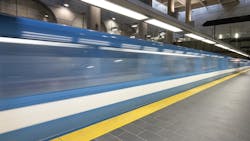Montréal Metro Blue line extension receives financial boost from federal government
A planned extension of the Montréal Metro Blue line received a funding commitment from the federal government that will provide nearly a third of the project’s total estimated cost.
Canada’s Prime Minister Justin Trudeau made the announcement July 4 that more than C$1.3 billion (approximately US$1 billion) will be invested in the project through the public transit component of the Investing in Canada Infrastructure Plan. The plan allows the federal government to invest more than C$180 billion (US$137.73 billion) over 12 years in public transit projects, green and social infrastructure, trade and transportation routes, and Canada's rural and northern communities.
"It's a big day for Montréal and for Montrealers. By investing in the Blue line extension, we're making a real difference in the lives of families, while creating good jobs and building a greener Montréal. Our government is working hard to support projects like this – projects that make our communities better – right across the country," said Prime Minister Trudeau.
The C$3.9 billion (US$2.98 billion) extension project will include five new stations along a six-kilometer (3.73-mile) route that will connect the current Saint-Michel station to Anjou. This funding will also support the construction of two bus terminals and a new park-and-ride.
"I am proud to announce our major contribution to the extension of the Montréal Metro's Blue line. The five new stations will simplify travel for the city's east end residents and the people who work there, so they spend less time in traffic and more time with their loved ones. Through projects like this, we are building a greener future for all, while encouraging the use of sustainable transportation and reducing the number of vehicles on the streets of Montréal," said Minister of Infrastructure and Communities François-Philippe Champagne.
The Société de transport de Montréal (STM) issued a statement following news of the federal government’s financial backing of the project:
[STM] welcomes today’s commitment from the federal government to finance the extension of the Blue line and the renewed support of the provincial government. As principal contractor and manager of this large project that will help improve mobility in Montréal, the STM, with its project office, has already been working for months to complete the preliminary steps. The work is set to begin in 2021.
Since fall 2017, with involvement from the Ministère des Transports du Québec, the Société québécoise des infrastructures and the Autorité régionale de transport métropolitain, the main activities carried out have aimed to optimize the project’s key parameters and analyze potential implementation methods as well as the master timetable, its budget framework and the phasing of its approvals. The project office’s work will intensify in the coming months in preparation for a business case approval in fall 2020, which should allow the work to begin in winter 2021 and commissioning to take place in fall 2026. Since January 2019 only, over 200 persons have contributed to the project office’s activities and resource mobilization is picking up pace.
Once opened, the Blue Line extension is expected to give an additional 17,000 people access to the STM system.
"The government of Quebec is committed to accelerating the project to extend the Blue Line to Anjou and is making the necessary efforts to make it happen. This project is key to improving mobility in the metropolitan area and stimulating development in Montréal's east end. After a 30-year wait, the development of the Montréal Metro is getting a reboot, and this is just the start," said Chantal Rouleau, Quebec Minister for Transport and Minister Responsible for the Metropolis and the Montréal Region.
About the Author

Mischa Wanek-Libman
Group Editorial Director
Mischa Wanek-Libman is director of communications with Transdev North America. She has more than 20 years of experience working in the transportation industry covering construction projects, engineering challenges, transit and rail operations and best practices.
Wanek-Libman has held top editorial positions at freight rail and public transportation business-to-business publications including as editor-in-chief and editorial director of Mass Transit from 2018-2024. She has been recognized for editorial excellence through her individual work, as well as for collaborative content.
She is an active member of the American Public Transportation Association's Marketing and Communications Committee and served 14 years as a Board Observer on the National Railroad Construction and Maintenance Association (NRC) Board of Directors.
She is a graduate of Drake University in Des Moines, Iowa, where she earned a Bachelor of Arts degree in Journalism and Mass Communication.
